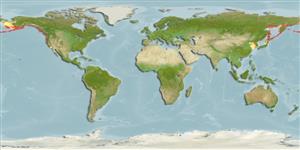Environment: milieu / climate zone / depth range / distribution range
Ökologie
seewasser demersal; tiefenbereich 0 - 73 m (Ref. 2850). Temperate
North Pacific: known only from the Bering Sea, the northern Gulf of Alaska (Kodiak) and southeastern Alaska (Yakutat). Records from further south must be considered highly doubtful, especially if specimens measure greater than 6 or 7 cm.
Size / Gewicht / Alter
Maturity: Lm ? range ? - ? cm
Max length : 7.0 cm SL Männchen/unbestimmt; (Ref. 50520)
Kurzbeschreibung
Bestimmungsschlüssel | Morphologie | Morphometrie
Rückenflossenstacheln (insgesamt) : 0; Rückenflossenweichstrahlen (insgesamt) : 32 - 33; Afterflossenstacheln: 0; Afterflossenweichstrahlen: 23 - 26; Wirbelzahl: 37 - 38. A small (less than 70 mm SL) species; caudal fin rays 11-12, pyloric caeca 18-31; body slender, maximum depth 14.6-24.1% SL; disk length 53.7-70.8% HL; skin lax and wrinkled, relatively thin, fragile; prickles present in both sexes at least during spawning; males with elongate, thickened, deeply incised anterior dorsal fin rays (Ref. 50520).
Occurs from intertidal areas to 73 m depth (Ref. 2850).
Life cycle and mating behavior
Maturities | Fortpflanzung | Spawnings | Egg(s) | Fecundities | Larven
Stein, D.L., C.E. Bond and D. Misitano, 2003. Liparis adiastolus (Teleostei, Liparidae): a new snailfish species from the littoral zone of the northeastern Pacific, and redescription of Liparis rutteri (Gilbert and Snyder, 1898). Copeia 2003(4):818-823. (Ref. 50520)
IUCN Rote Liste Status (Ref. 130435)
Bedrohung für Menschen
Harmless
Nutzung durch Menschen
Tools
Zusatzinformationen
Download XML
Internet Quellen
Estimates based on models
Preferred temperature (Ref.
123201): 2.2 - 13.2, mean 6.3 °C (based on 487 cells).
Phylogenetic diversity index (Ref.
82804): PD
50 = 0.5000 [Uniqueness, from 0.5 = low to 2.0 = high].
Bayesian length-weight: a=0.00525 (0.00237 - 0.01161), b=3.15 (2.96 - 3.34), in cm total length, based on LWR estimates for this (Sub)family-body shape (Ref.
93245).
Trophic level (Ref.
69278): 3.3 ±0.5 se; based on size and trophs of closest relatives
Widerstandsfähigkeit (Ref.
120179): mittel, Verdopplung der Population dauert 1,4 - 4,4 Jahre. (Fecundity assumed < 1000).
Fishing Vulnerability (Ref.
59153): Low vulnerability (10 of 100).
